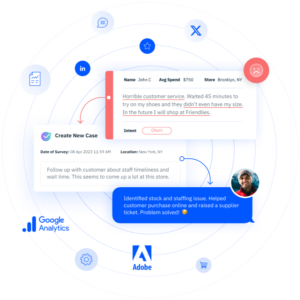Persuasive Survey Design
While browsing entertainment options on a 10-hour trans-Atlantic flight, I spotted a “feedback survey." Unfortunately, the feedback process quickly went downhill with too many clicks, questions I did not understand, and a lengthy feedback form. The designers of the form had failed to consider the feedback process from the respondent’s perspective. In my chapter Persuasive Survey Design in Allegiance’s book, Delivering Customer Intelligence, I discuss in detail how good survey programs designed from the respondent perspective can lead to higher response and completion rates and provide a more engaging, user-friendly experience.While browsing entertainment options on a 10-hour trans-Atlantic flight, I spotted a “feedback survey.” Included in the survey was my seat number, a valuable piece of information that could reveal more information about me. I wondered if and how the airline would use this content to gain insights and find patterns.
The airline was off to a great start by engaging me when I had time to ruminate and provide honest feedback. Unfortunately, the feedback process quickly went downhill with too many clicks, questions I did not understand, and a lengthy feedback form.
The designers of the form had failed to consider the feedback process from the respondent’s perspective. In my chapter Persuasive Survey Design in Allegiance’s book, Delivering Customer Intelligence, I discuss in detail how good survey programs designed from the respondent perspective can lead to higher response and completion rates and provide a more engaging, user-friendly experience.
My survey experience made me think about what key factors grab consumer’s attention and keep it. I immediately thought of B. J. Fogg, a leading proponent of respondent psychology at the Stanford Persuasive Technology Lab who developed the “Fogg Behavior Model (FBM)” to help our understanding of human behavior and how it can be applied to survey design.
According to the FBM, in order for a person to perform a target behavior, he or she must be sufficiently motivated, have the ability to perform the behavior, and be triggered to perform the behavior—all at the same time. Core motivators include sensation (pleasure/pain), anticipation (hope/ fear), and social cohesion (acceptance/ rejection). These are essential for perceived respondent experience.
For example, surveys that include awards increase motivation and the likelihood that respondents will complete the survey. Also, the simpler a survey is, the more likely people are to respond. Once you have persuaded the user to fill out your survey, you should use the FBM throughout the three key stages of the feedback process—invitation, response and post response.
The target behavior for the invitation is to inspire the respondent to click on the link within the email or the feedback button on your site. One way to motivate users to respond to your survey is to tell them how their feedback will benefit them, such as improved products and services, rewards and coupons. For example, the airline I used during my recent trip could have motivated me more by giving away a few extra miles for survey completion and re-wording the button as “Give feedback, earn 1,000 bonus miles.”
Bottom line: Using respondent psychology and the Fogg Behavior Model to create simple, engaging surveys leads to higher response and completion rates. It involves keeping the survey objective and respondent experience in the forefront during the entire design process.
Tulsi Dharmarajan is Director of Product Management & Design for Allegiance
